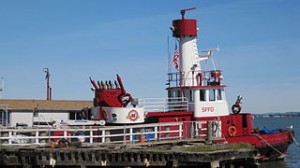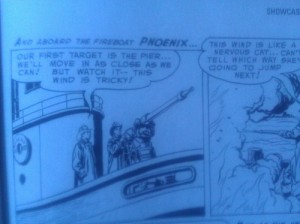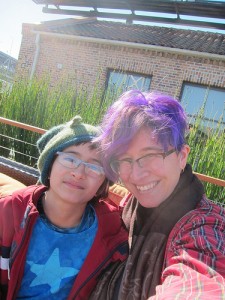Yesterday I headed into the Mozilla San Francisco office with my son Milo in tow. It was sunny and beautiful! We had lunch at the High Dive, a little diner right on the waterfront. He tried out my TV-B-Gone delux and we laughed very hard at the feeling of being super-spies with our spy gadget. Or, he might have just been laughing at me. It’s hard to tell!
On the walk back from the diner I pointed out the old SFFD building and that there was a fireboat on the other side of it. We went round to watch the boat pull out of its berth, apparently giving some non-firemen a tour in the sparkly winter sunshine. On its side it was labeled Guardian, boat #2. There was a sign in front of the building explaining the history of San Francisco fireboats. We both avidly read this sort of thing. The more famous of SF’s fireboats is the Phoenix from 1955, which saved the Marina district after the 1989 Loma Prieta quake. “I guess it’s still useful, even though it’s old-fashioned” he commented. The fireboat is also extremely cute; stubby and with a little striped tower, like a tugboat.
At the office I picked up a B2G test drivers phone so I can help test FirefoxOS. Sights of the office for my son were: my cube (unexciting), the shelves of free snack food (from which, abstemiously, he snagged a banana and two starburst candies), and the roof with its view of the Bay Bridge. The night before, I had read him the first few chapters of Flatland. He had picked it up to read on the bus and while I worked, since it’s lighter to carry than the Draconomicon. He kept interrupting my concentration on email and Bugzilla to read me bits from Flatland.
I figured I would return the favor. “So, would you like to know what I am actually working on?” Yes he would. Whatever I do for my job On The Computer is something of a mystery. Even to me . . .
We read the principles in the Mozilla Manifesto. (“Nice, Mom. That sounds like you. But, no offense, but, well, I’m already reading a book where people explain boring things about politics.”) Okay, moving on. I explained that there is a non-profit Mozilla Foundation as well as Mozilla Corporation, then that there is a greater Mozilla community (Mozillians!), who all work on making various tools better: Firefox in various flavors, which he is familiar with, but also Thunderbird, Bugzilla, and other stuff.
He got that Bugzilla is a product anyone can download, install, and use to track problems, but that Mozilla has its own implementation of Bugzilla, which we call BMO (for bugzilla.mozilla.org). Someone puts a bug into BMO; then a lot of people might look at it and do something with or to it.
My job as the newly-fledged Bugmaster is to help manage the huge volume of bugs in BMO. I pointed out that in a search for bugs filed in the last 24 hours the ID numbers for the bugs are up to 82600. So 800,000 bugs have been reported since Mozilla has been around, over 10 years ago.
(ETA: You need to have a bugzilla.mozilla.org login in order to use the above link. Hmmm.)
I’m taking a look at triaging new bugs, or in this case, adding information to bugs with UNCONFIRMED status and moving them to some new status. Generally, a bug that is UNCONFIRMED has not been triaged. My big question right now is, though there is no natural “end” to triaging a bug, how can we demarcate untriaged and partly triaged, bugs from ones that are… let’s say… good enough for now for a developer to look at? I could encourage people who do something with a bug to move it out of UNCONFIRMED. I could invent a system of whiteboard tags or flags to mark up bugs for the bugmastering throngs who live in #bugmasters.
Anyway, I didn’t go into that for Milo. I gave a very quick, hand-wavy explanation of how FOSS projects tend to have a “trunk” which is basically the code that’s been tested and released, trying to give an impression for him that a lot of people touch that code as it gets committed to branches, tested, and merged in to the trunk, watched over by Sheriffs. I showed him the tinderbox push log page which displays commits and a battery of automated tests that they pass or fail. Milo (who is not into programming at all) commented that there is Mozilla, and Bugzilla, and everythingzilla, so there should be Yggdrazilla, like the world-tree from Norse myth, to describe this cool giant tree of code.
I love the name Yggdrazilla! Though I’m not sure what exactly it would describe!
This morning as I fired up to work from home, Milo came in to show me an amazing coincidence! One of his giant phone book sized DC comics compilations from Christmas has a comic book about Center City and its new fireboat, the Phoenix!
We stopped on the way home at a TMobile store to get a SIM card for the B2G test phone, and then excitedly fought over it to play Little Alchemy on the bus and after dinner. I’m going to set aside time to poke at FirefoxOS (aka B2G or Boot2Gecko) every day but am not sure I’m going to use it for my primary phone. I informally reported one UI issue with it, and today would like to double check on that and will probably put it into Bugzilla. It immediately wanted to import all my contacts from Facebook, and all the contact info for my Facebook friends. Wow. Scary but interesting. FirefoxOS is going to released soon and will make smart phones a lot cheaper and therefore more accessible for people. As soon as I can buy one for Milo, I will — it will be his first smart phone. It’s really tempting to try to write an app for it.



Milo so has your number re: boring things about politics.
Those UNTRIAGED bugs have to get to WASHED status, right? Rinse all the confusion off them and put them in the right rack for further action?
It is funny but on my very first day at Mozilla I was hanging out with some of the Bugzilla hacking team – mcote, glob, and dkl — and glob told me that one thing they would NOT consider doing is adding any new statuses.
It could be done with flags though!